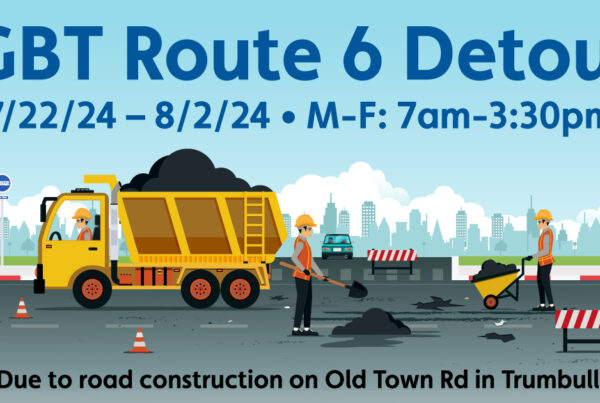 Legislative Brief
Legislative Brief
The Future of Free Bus Service in Connecticut
$40M or 20% of Operating Expenses in CT • Who Pays for Free Fares? Ask the Riders • Public Vetting Required
Oppose proposed bill No. 5974, and allow the Department of Transportation the time to take a more considered approach to the long-term impact of such a program on the State’s mass transit system. This work is already underway.
Oppose elements of any bills that dictate fare structure. Proposed bills S.B. No. 1079, H.B. No. 6743, H.B. No. 5974, and S.B. No. 208 all have elements related to fares.
Oppose elements of any bills that dictate fare structure.
What is the True Cost of a Bus Ride?
Bus services across Connecticut have been fare free since April 2022. There are some important matters to consider regarding free fares, including the true cost of a bus ride, the importance of fares for funding bus operations, the required public hearing process for changing fares, and equity.
$1
AVG Bus Fare in CT
Fares are Low, Affordable
Before the pandemic, the average cost of a bus ride was about one dollar.
Discounted Fares Available
There are many discounted and time-based passes available to riders, which drives the average cost of a boarding down from the base fare. There are day passes, weekly passes, and monthly passes which all provide for a lower cost to board.
Half Fares for Seniors and People with a Disability
Additionally, all transit operations in Connecticut accept half fares for seniors, riders with disabilities, and those on Medicaid. In Bridgeport, these riders can have unlimited access to the bus system for $2.00 a day or $35.00 a month.
Helping Those in Need
It is true that even with the current discounts, there are some who cannot afford any bus fare.
For those riders, GBT works with local social agencies and other organizations to help people in need ― from students to refugees to people in reentry programs ― to get access to transit.
Fares Cover 20% of Operating Costs, on Average
Fare revenue is a critical part of the funding needed of operate Connecticut’s bus services at current levels. Collected fares are invested back into the provision of service. The percent of operating expenses paid for by fares is known as the operating ratio. In Connecticut, operating ratios vary by region. This is due to ridership, fare structure, and the extent to which the operations serve more populated areas.

Prior to the pandemic, the fare recovery ratio in Connecticut was approximately 20%, or $40 Million ― a major part of transit operating budgets. Without fares or the appropriation of an equivalent amount of funding, there would need to be a 20% reduction in bus services if the legislature passes proposed bill No. 5974. For example, $40M pays for about 364,000 hours of bus service or 62 buses operating 16 hours a day, every day.
Is a free fare program in CT really sustainable? And, if not, what services would be cut?
How Will Operating Costs be Funded?
The current fare holiday is being funded with an infusion of federal operating assistance, which shows no signs of being permanent. If free fares were to continue where do we find $40M for operating costs? While fares represent about 20% of the total operating expenses, the remainder is derived from a combination of municipal and mostly State investment. State investment in bus operations comes from the Special Transportation Fund (STF).
Prior to the pandemic, there was serious concern about the solvency of the STF. At that time, GBT was facing a very real threat of a 15% reduction in State investment which was only narrowly averted. In 2018, the STF Lockbox ballot measure was passed, ensuring that all funding deposited into the STF would be used for transportation projects only. One major source of funding for the STF is the gasoline tax, which, along with bus fares, was suspended at a reported cost of $30M per month.
2026
PROJECTED STF DEFICIT―CT Office of Policy and Management
Ask the Riders
Over the years, GBT has conducted many public hearings ― riders bring a unique perspective and understanding of the service needs in their communities. In addition, the public vetting of any fare changes is required by the U.S. Department of Transportation for agencies using federal funding. Input from the public related to bus service is vital to creating meaningful change.
It is important for advocates of permanent free fares to understand fully the ability of the State to fund such a program in perpetuity and the damage to the current mass transit system that could result with a funding shortfall.
What is the best use of funds from a rider’s perspective?
Clearly there are some who cannot afford to pay bus fare. There are also some who can and who would prefer new investment to expand and improve current services. When we consider the continuation of the fare free program, we need to ensure a sustainable funding stream, use rider input to inform our decisions, ensure a balance between service improvement and expansion, and use equity (need) to target such programs.
Let’s assume that the State has the $40M to continue the fare free program. Many would likely support this. However, there may be other riders who would prefer that the new funding be used for the expansion of service.
There are routes in the State where buses are often full and have to pass by waiting riders – do these riders want free fares or do they want expanded bus service?
There are buses that pass by waiting riders because they are full. Do those riders want free fares or do they want more service?
Free fares are not a choice if other options are not considered. The real question is: what is the best use of new investment from a rider’s perspective?
Oppose proposed bill No. 5974, and allow the Department of Transportation the time to take a more considered approach to the long-term impact of such a program on the State’s mass transit system. This work is already underway.
Oppose elements of any bills that dictate fare structure. Proposed bills S.B. No. 1079, H.B. No. 6743, H.B. No. 5974, and S.B. No. 208 all have elements related to fares.
Oppose elements of any bills that dictate fare structure.
Newsletter Signup
Like what you see? Signup for our newsletter!
NEWSLETTER SIGNUP>>
 Alerts
Alerts



